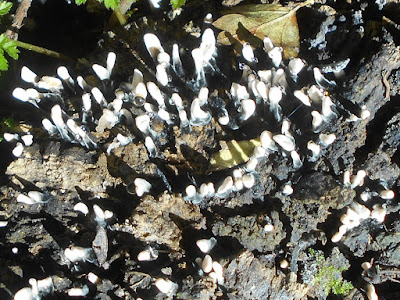Hogweed, Heracleum sphondylium, is familiar to all but the most urbanized of people. It flourishes on the grass verges beside roads, where the soil has been enriched by constant mulches of vegetation as 'weeds' are cut back. It is not surprising that this member of the Carrot Family, being so common, attracts a large number of insects. Thus we have the picture-winged fly, Euleia heraclei, a moth Agonopterix heracliana and the fungi Ramularia heraclei and Puccinia heraclei. There are dozens of other species, particularly among the diptera who, whilst not dependent on hogweed, habitually make use of it in various ways. Humans, oddly, seem to have found little value in the plant.
 |
Hogweed in flower, Byfield Pocket Park. 30 October, 2019
|
 |
Hogweed in close-up shows the zygomorphic (bilaterally symmetrical)
flowers characteristic of the Carrot Family.
|
As I said earlier, hogweed and yarrow are vaguely similar but whereas the branches of hogweed spread out to form an umbel, those of yarrow form a corymb, with the branches of the inflorescence arising from different points on the stem. Similarities are superficial rather than actual.
 |
Yarrow in flower on spare land adjacent to the burial ground. Byfield
Pocket Park, 30 October, 2019
|
Close examination of the flowers shows that structurally they are quite different and accordingly Yarrow, Achillea millefolium, is placed in the Daisy Family, Asteraceae (formerly the Compositae). An alternative name is Milfoil and older names include Thousand leaf, Nose-bleed, Staunchweed and Poor Man's Pepper. Unlike hogweed, its properties have been recognised from ancient times, even before it was applied, according to legend, to the heel of Achilles when he was wounded at the Battle of Troy. Apparently it was traditionally recommended for the treatment of 'those that have been wounded with iron' and in some areas a dialect name was Carpenter's Grass. Herbalists have employed it 'to open the pores freely and purify the blood'.
 |
A closer view reveals the composite nature of the flowers, hence its
membership of the daisy Family
|
Curiously, one other feature links yarrow and hogweed: both can be found flowering in the midst of winter. Draw what conclusions you will from that!



































